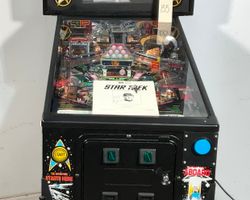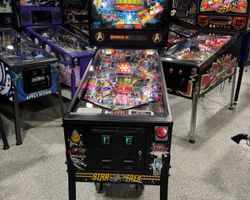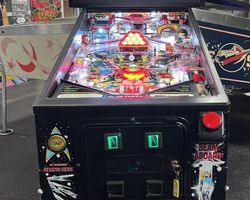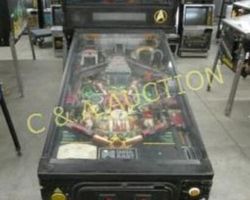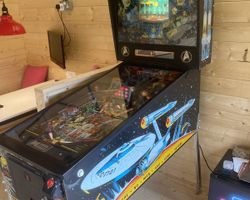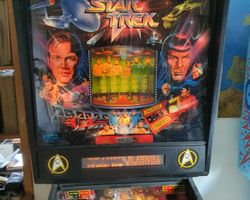Star Trek
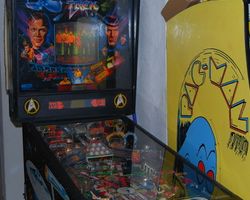
Average Prices: USD $400 to $2,200
Produced: October, 1991
Production Run: 4,400 units
Machine Type: Solid State Electronic
MPU: DataEast/Sega Version 3
Players: 4
Design by: Ed Cebula, Joe Kaminkow
Art by: Kevin OConnor, Margaret Hudson, Kevin O'Connor
Music by: Brian Schmidt
Sound by: Brian Schmidt
Software by: Kristina Donofrio
The Star Trek pinball machine, released by Data East USA, Inc. in October 1991, brought the beloved original television series to the pinball playfield. This machine arrived at a time when licensed themes were becoming increasingly prevalent in the pinball industry, and Data East, known for its rapid development cycles and embrace of popular culture, was a fitting manufacturer for such an ambitious project. The machine capitalized on the enduring popularity of Captain Kirk, Spock, and the crew of the USS Enterprise, aiming to transport players directly into their galactic adventures.
The design team behind Star Trek featured Ed Cebula and Joe Kaminkow, who contributed to the machine’s overall concept and layout. Brian Schmidt was responsible for both the music and sound design, drawing heavily on the iconic soundscape of the Star Trek universe. The vibrant artwork, a crucial element in immersing players in the theme, was crafted by Kevin O'Connor and Margaret Hudson, while Kristina Donofrio handled the software development, bringing the game's rules and animations to life. With a production run of 4,400 units, manufactured between October 1991 and January 1992, Star Trek found its way into arcades and collections, leaving a distinct mark. A notable piece of trivia connected to the machine is the inclusion of genuine voice callouts from James Doohan, who portrayed Lt. Cmdr. Montgomery Scott (Scotty) in the original series, enhancing the authenticity of the experience. Additionally, the phrase "live long and prosper" heard at the game's conclusion was spoken by Fred Young.
Signature Features and Design
Star Trek is characterized by several standout elements that contribute to its distinctive identity and gameplay experience. Central to its visual appeal is the mechanical backbox animation, a patented "Transporter Effect." This innovative feature uses a moving double layer of semi-transparent pictures to create the illusion of the Starfleet crew beaming in and out. This visual spectacle activates notably at the start of multiball, as the crew "beams out" after all Dilithium crystals are collected, and then "beams back in" when multiball concludes, reinforcing the theme in a dynamic way. This animated backglass effect stands as one of the machine's most celebrated attributes, frequently cited as a highlight of its design.
On the playfield, a prominent "Primary crystal" target continuously sways back and forth, adding a dynamic challenge to shot accuracy. This moving target serves as a focal point for various game objectives and adds an element of unpredictability to shots aimed at the center of the playfield. The machine also incorporates a mirror at the back of the playfield, a design choice intended to offer players a clearer view of the top rollover lanes, which would otherwise be partially obscured. The artwork, executed by Kevin O'Connor and Margaret Hudson, extends across the playfield, cabinet, and backglass, presenting a cohesive and appealing visual package that effectively captures the aesthetic of the original Star Trek series. The sound design, featuring classic effects, music, and the authentic voice talents of the original Star Trek cast, further elevates the thematic immersion, utilizing the machine's stereo sound capabilities for a rich audio experience.
Playfield and Mechanics
The playfield layout of Star Trek is designed for straightforward engagement, balancing accessible shots with clear objectives. It features two ramps, one on each side, which are key targets for flow-based play and scoring. Three pop bumpers, located in the upper playfield, contribute to chaotic ball movement and score accumulation. Two slingshots flank the lower playfield, deflecting the ball and adding to the urgency of gameplay. A notable element is the presence of eight drop targets, arranged in two distinct 4-bank sets, requiring precision to clear and activate specific features or bonuses.
The aforementioned "Primary crystal" swinging target is positioned centrally, serving as a primary target for various modes and an accelerator for bonus scoring. A kick-out saucer provides an entry point for certain modes or awards, delivering the ball back into play after a successful shot. The automatic plunger ensures a consistent skill shot launch, leading into an extended video mode sequence where players aim to destroy ten enemy ships displayed on the Dot Matrix Display (DMD). The overall design philosophy emphasizes a direct and understandable game flow, making it approachable for newcomers while offering satisfying shots for more experienced players. While the layout is generally well-regarded for its simplicity and fun, some players observe a slight asymmetry in the design. Visually, the playfield is vibrant, with artwork and lighting carefully integrated to depict scenes and characters from the Star Trek universe, enhancing the overall aesthetic.
Gameplay Dynamics
Star Trek employs a rule set that is easy to grasp, allowing players to quickly understand objectives and progression. The core gameplay revolves around hitting a series of targets and ramps to activate modes and build score. Multiball, a central feature, is a three-ball experience initiated by collecting all Dilithium crystals. Successfully hitting the swinging target repeatedly is a primary strategy for increasing the bonus multiplier and progressing towards the "Unlimited Millions" feature, where high scores can rapidly accumulate.
The "Scanner" feature, typically associated with a vertical up-kicker (VUK), serves as a gateway to various game modes, including the simple yet engaging Video Mode. In this mode, players use the flipper buttons to navigate crosshairs on the DMD, aiming to shoot down enemy ships. While straightforward, this mode provides a brief diversion from the main playfield action. Other objectives include completing drop target banks to light features or advance mode progression. Players often focus on chaining ramp shots and creating combos for higher scores, as the ramps provide satisfying shot feedback. Despite the clear objectives, some aspects of the gameplay present challenges. The right outlane can be particularly unforgiving, leading to unexpected drains, and issues with the ball eject from the right side of the upper playfield can occasionally result in direct outlane drains, requiring players to adapt their strategies to mitigate these risks.
Reception and Legacy
The reception of Data East's Star Trek pinball machine within the community is largely positive, particularly among fans of the original television series. Its primary strength lies in its exceptional theme integration; players consistently praise how authentically the machine captures the spirit, characters, and sounds of Star Trek. The artwork, spanning the playfield, cabinet, and backglass, is frequently cited as attractive and well-executed, contributing significantly to this immersive experience. The "Transporter Effect" backbox animation is a distinctive highlight, often regarded as one of the most unique and impressive features Data East produced, elevating the machine's visual appeal beyond typical static backglasses.
The sound package, featuring classic effects, music, and the voice talents of original cast members like Scotty and Bones, is another major draw, enhancing the nostalgic appeal. From a gameplay perspective, Star Trek is valued for its simple, approachable ruleset, making it fun and accessible for both casual players and beginners. The ramp shots and the ability to link combos are often highlighted as satisfying aspects of the gameplay. For collectors, it is often seen as a desirable machine, offering good value for its thematic depth and entertainment.
However, the machine is not without its criticisms. Some experienced players find the ruleset to be "shallow" and lacking in long-term depth, leading to a sense of repetitiveness over extended play sessions. The voice callouts, while authentic, can become repetitive for some. The central moving target, while dynamic, is sometimes seen as too easy to hit, potentially dominating gameplay. Common technical observations include a background hum in the audio, a known characteristic of some Data East machines, and the early Dot Matrix Display animations, while functional, are occasionally perceived as simplistic compared to later machines. The challenging right outlane and potential ball eject issues from the upper playfield are also points of contention for some players, impacting ball times.
Despite these criticisms, Star Trek maintains a favorable reputation, especially for its strong thematic presence and its unique backbox animation. It stands as an example of Data East's capacity to deliver engaging, licensed pinball experiences that resonate with a dedicated fanbase. Its enduring appeal lies in its ability to transport players back to the bridge of the Enterprise, offering a straightforward yet enjoyable pinball journey into the final frontier.
Sponsored Links
 Ebay Listings
Ebay Listings
 Auction Results
Auction Results
| Cost | Location | Date |
|---|---|---|
| USD $5,000 |  Florida, United States Florida, United States |
30 March, 2025 |
| USD $6,999 |  California, United States California, United States |
19 March, 2025 |
| USD $5,000 |  Florida, United States Florida, United States |
03 March, 2025 |
| USD $1,950 |  Pennsylvania, United States Pennsylvania, United States |
18 February, 2025 |
| USD $3,000 |  California, United States California, United States |
07 November, 2024 |
| GBP £3,300 |  London, United Kingdom London, United Kingdom |
05 October, 2024 |
| USD $4,995 |  Ohio, United States Ohio, United States |
03 September, 2024 |
| EUR €2,356 |  Niedersachsen, Germany Niedersachsen, Germany |
09 June, 2024 |
| GBP £2,500 |  United Kingdom United Kingdom |
24 May, 2024 |
| USD $5,000 |  Florida, United States Florida, United States |
05 April, 2024 |


Private Policy · Search Website · Contact Us
As an eBay Partner, we may earn a commission from qualifying purchases made through links on this site, at no additional cost to you.
All trademarks and copyrighted materials remain property of their respective owners. All other content copyright 2007 - 2025 Pinpedia.

